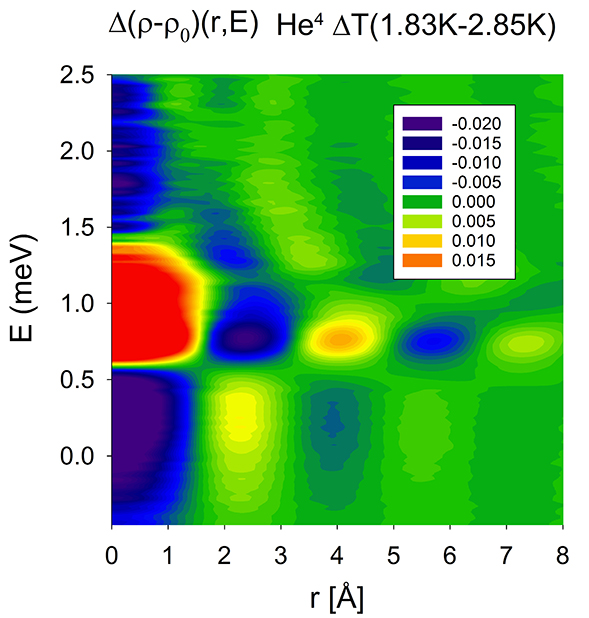Discovering Secrets of Superfluids
Observed atomic dynamics helps explain bizarre flow without friction that has been puzzling scientists for decades.

The Science
When helium gas is cooled to extremes it becomes a liquid and behaves oddly—it can flow without friction as a superfluid. This phenomenon has been explained as the formation of a new quantum state of matter. And—the 1962 Nobel Prize was for research into helium in the superfluid state. However, after decades, the atomic mechanism of superfluid flow is still not fully understood. Recently, characterization with neutron scattering revealed atomic dynamics in liquid helium that were never seen before. The features that show up only in the superfluid state are believed to result from “quantum tunneling.” Quantum tunneling occurs when a particle passes through an energy barrier rather than going over it.
The Impact
Answering some tough questions gets easier with detailed insights into the friction-free flow of super cold helium. These questions include how to transmit electricity without loss and the nature of the universe. This study explains the physical mechanisms for superfluidity. In doing so, it offers insights into the phenomena found in helium and other exotic states of matter.
Summary
Superfluidity is the odd property of a liquid in which it has zero-resistance for flow, and thus flows without loss of kinetic energy. The most common isotope of helium, helium-4, shows superfluidity near absolute zero temperature (less than -270 degrees Celsius). While it has been the subject of extensive study, the details of the microscopic state, including dynamic atom-atom correlations in the superfluid state, are not fully understood. Furthermore, because the atoms are strongly correlated in liquid, the description of its local dynamics is challenging.
Using inelastic neutron scattering, researchers identified the real-space mechanism of flow. Typically, the inelastic neutron scattering data are presented in the momentum and energy space. However, to be more informative, a team led by researchers at Oak Ridge National Laboratory transformed the data to real space in the form of the dynamic pair-density function. Researchers carried out a detailed analysis of the neutron scattering data to determine the length scale and the energy scale of the real-space mechanism of the superfluid. A new spectral peak was discovered and is explained as coherent atomic tunneling. This coherent tunneling of helium-4 atoms provides evidence of a real-space mechanism of superfluid flow. This conclusion provides the key to understanding the atomistic mechanism of flow in superfluids.
Contact
Takeshi Egami
Oak Ridge National Laboratory and the University of Tennessee
egami@utk.edu
Funding
This work was supported by the U.S. Department of Energy (DOE), Office of Science, Office of Basic Energy Sciences, Spallation Neutron Source, a DOE Office of Science user facility, and the Ministry of Economy, Industry and Competitiveness (Spain).
Publications
W. Dmowski, S.O. Diallo, K. Lokshin, G. Ehlers, G. Ferré, J. Boronat, and T. Egami, “Observation of dynamic atom-atom correlation in liquid helium in real space.” Nature Communications 8, 15294 (2017). [DOI: 10.1038/ncomms15294]
Highlight Categories
Performer: University , SC User Facilities , BES User Facilities , SNS
Additional: Collaborations , International Collaboration



